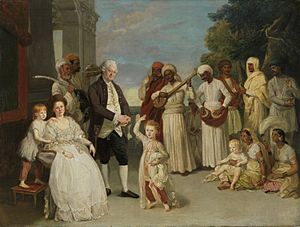Elijah Impey facts for kids
Quick facts for kids
Sir Elijah Impey
|
|
|---|---|
 |
|
| Chief Justice of the Supreme Court of Judicature at Fort William in Bengal | |
| In office 22 October 1774 – 3 December 1783 (Effectively). Resigned 1 November 1787 |
|
| Sole Justice of the Sadr Diwani Adalat | |
| In office 24 October 1780 – 5 November 1782 |
|
| Member of Parliament for New Romney |
|
| In office 1790–1796 |
|
Sir Elijah Impey (born June 13, 1732 – died October 1, 1809) was an important British judge. He became the very first chief justice of the Supreme Court in Bengal, India. He also served as a Member of Parliament in the United Kingdom.
Contents
Who Was Sir Elijah Impey?

Elijah Impey was the youngest son of Elijah and Martha Impey. He went to school at Westminster School with Warren Hastings. Hastings became a very close friend throughout Impey's life. After school, Impey went to Trinity College, Cambridge in 1752. He finished his studies there in 1756.
Early Career and Moving to India
Impey became a lawyer in 1756. In March 1774, he was chosen to be the first chief justice. This was for the new supreme court in Calcutta, India. He was also given the title of "Sir" (knighted) that same month.
On his way to India, he learned the Bengali and Urdu languages. Once he arrived, he also studied Persian. This helped him understand the local people better.
The Impey Album
Sir Elijah Impey and his wife, Mary Impey, were very interested in nature. Starting in 1777, they hired local artists. These artists painted different birds, animals, and plants from India. They tried to paint them life-sized when possible. They also showed them in their natural homes. This amazing collection of paintings is now known as the Impey Album.
Important Legal Cases
In 1775, Impey was in charge of a big trial. A man named Maharaja Nandakumar was accused of a serious crime. Later, in 1787, Impey himself faced accusations. This was about how he handled Nandakumar's case. Some people, like Macaulay, criticized him. They said he worked with Warren Hastings unfairly.
However, a detailed study by Sir James Fitzjames Stephen looked at the trial again. He concluded that Nandakumar had a very fair trial. Stephen also said that Impey acted with complete fairness. He showed as much kindness as his job allowed.
Later Life and Retirement
In 1790, Impey became a Member of Parliament. He represented the area of New Romney. He served as an MP for seven years. After that, he retired in 1796. He moved to a place called Newick Park near Brighton.
Sir Elijah Impey passed away in 1809. He was buried in London. A special monument in the church remembers him and his wife. He married Mary Reade in 1768. They had five sons together.
What Is Sir Elijah Impey's Legacy?

A painting of Sir Elijah Impey hangs in the Kolkata High Court in India. This painting was done by Johan Zoffany. Other famous artists also painted him. These include Tilly Kettle, Thomas Lawrence, and William Beechey.
His wife, Mary Impey, has a special legacy too. A beautiful bird, the Impeyan pheasant (Lophophorus impejanus), is named after her!
Where Can You Learn More?
- The Oxford Dictionary of National Biography

